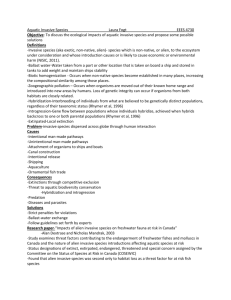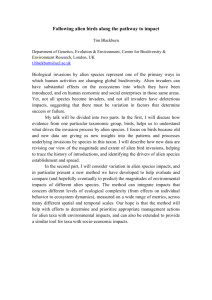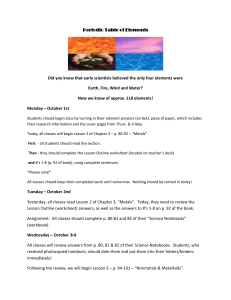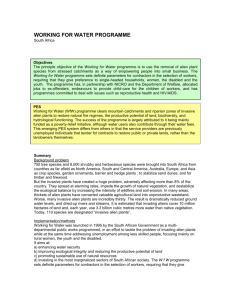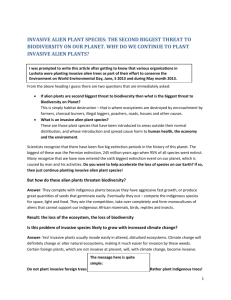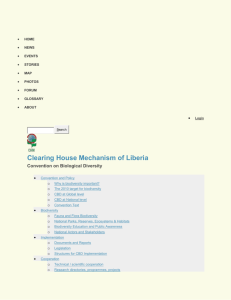English - Convention on Biological Diversity
advertisement
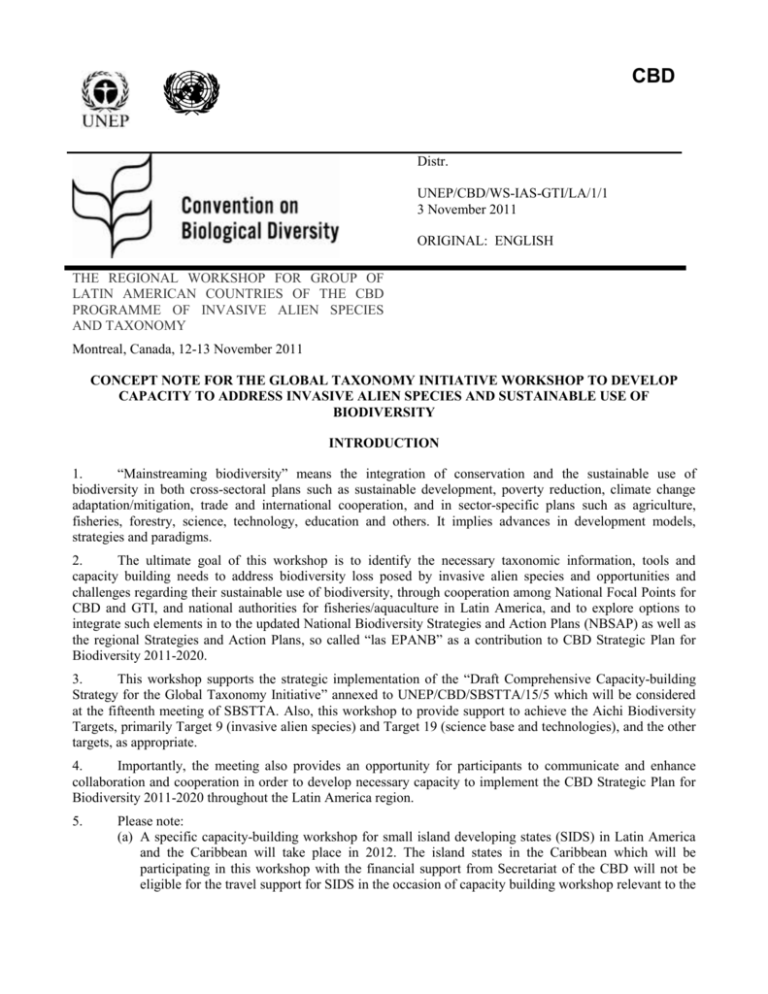
CBD Distr. UNEP/CBD/WS-IAS-GTI/LA/1/1 3 November 2011 ORIGINAL: ENGLISH THE REGIONAL WORKSHOP FOR GROUP OF LATIN AMERICAN COUNTRIES OF THE CBD PROGRAMME OF INVASIVE ALIEN SPECIES AND TAXONOMY Montreal, Canada, 12-13 November 2011 CONCEPT NOTE FOR THE GLOBAL TAXONOMY INITIATIVE WORKSHOP TO DEVELOP CAPACITY TO ADDRESS INVASIVE ALIEN SPECIES AND SUSTAINABLE USE OF BIODIVERSITY INTRODUCTION 1. “Mainstreaming biodiversity” means the integration of conservation and the sustainable use of biodiversity in both cross-sectoral plans such as sustainable development, poverty reduction, climate change adaptation/mitigation, trade and international cooperation, and in sector-specific plans such as agriculture, fisheries, forestry, science, technology, education and others. It implies advances in development models, strategies and paradigms. 2. The ultimate goal of this workshop is to identify the necessary taxonomic information, tools and capacity building needs to address biodiversity loss posed by invasive alien species and opportunities and challenges regarding their sustainable use of biodiversity, through cooperation among National Focal Points for CBD and GTI, and national authorities for fisheries/aquaculture in Latin America, and to explore options to integrate such elements in to the updated National Biodiversity Strategies and Action Plans (NBSAP) as well as the regional Strategies and Action Plans, so called “las EPANB” as a contribution to CBD Strategic Plan for Biodiversity 2011-2020. 3. This workshop supports the strategic implementation of the “Draft Comprehensive Capacity-building Strategy for the Global Taxonomy Initiative” annexed to UNEP/CBD/SBSTTA/15/5 which will be considered at the fifteenth meeting of SBSTTA. Also, this workshop to provide support to achieve the Aichi Biodiversity Targets, primarily Target 9 (invasive alien species) and Target 19 (science base and technologies), and the other targets, as appropriate. 4. Importantly, the meeting also provides an opportunity for participants to communicate and enhance collaboration and cooperation in order to develop necessary capacity to implement the CBD Strategic Plan for Biodiversity 2011-2020 throughout the Latin America region. 5. Please note: (a) A specific capacity-building workshop for small island developing states (SIDS) in Latin America and the Caribbean will take place in 2012. The island states in the Caribbean which will be participating in this workshop with the financial support from Secretariat of the CBD will not be eligible for the travel support for SIDS in the occasion of capacity building workshop relevant to the GTI and invasive alien species in 2012. However, participation of these countries to the workshop in 2012 with their own finance will be welcomed. (b) The outcome of this workshop will be further discussed at the Regional Workshop for Mesoamerica on Updating National Biodiversity Strategy and Action Plans to be held in San José, Costa Rica from 28 November - 2 December 2011 and provide inputs to relevant sessions at the FAO COFI Sub-Committee on Aquaculture to be held in Cape Town, South Africa, from 26-30 March 2012. 6. This workshop is organized by the Secretariat of the Convention on Biological Diversity with the generous financial contribution by the Government of Japan, and in collaboration with the Food and Agriculture Organization of the United Nations. . A. Invasive Alien Species 7. Invasive alien species1 are those alien species which threaten ecosystems, habitats or species -Article 8(h) of the Convention on Biological Diversity. In some ecosystems, such as many island ecosystems, invasive alien species are the leading cause of biodiversity loss. In addition, they can pose a threat to food security, human health and economic development. Increasing trade and travel translates into greater risks of biological invasion unless prevention, eradication, and control of invasive alien species become national priorities. 8. . Under the Convention, the COP adopted “the guiding principles for the prevention, introduction and mitigation of impacts of alien species that threaten ecosystems, habitats or species” annexed to decision VI/232 in 2002. The COP also identified the pathways of introduction of alien species and pointed the needs to address the gaps and inconsistencies of the international regulatory framework in 2006. Further efforts to close the gap in international regulatory framework have continued through the COP and communication among the relevant international organizations setting the regulatory framework relevant to invasive alien species. However, it has become clear that strong cross-sectoral collaboration at national level to control the transboundary movement of live species and contaminated goods is necessary to implement the Guiding Principles and other international agreements, including the multilateral environmental agreements. 9. At the ground level prevention is the most cost-effective means for addressing invasive alien species. Early detection of entry of alien species and rapid response, ideally eradication of alien species, are also critically important approaches to minimizing the spread and impact of invasive alien species. 10. It is important to note that information on alien species is essential for science-based risk assessment., not only for the pathways described above, but also for planned introductions where countries need to take a decision on whether or not to deliberately introduce a species based on a sound risk assessment. The CBD and the Code of Conduct for Responsible Fisheries (CCRF) call for accurate assessments of the risks of introduction of alien species and are promoting the creation of information sources and an exchange of information on alien species, their biological and ecological attributes, and potential impacts (both positive and negative). Early detection of entry and management of the entered alien species also requires the correct identification of the species. Capacity to find and apply taxonomic information tools is a basic need both in developing and developed countries. 1 The following definitions are used since the Guiding Principles were adopted by the COP to the CBD: "alien species" refers to a species, subspecies or lower taxon, introduced outside its natural past or present distribution; includes any part, gametes, seeds, eggs, or propagules of such species that might survive and subsequently reproduce; "invasive alien species" means an alien species whose introduction and/or spread threaten biological diversity (For the purposes of the present guiding principles, the term "invasive alien species" shall be deemed the same as "alien invasive species" in decision V/8 of the Conference of the Parties to the Convention on Biological Diversity.); 2 One representative entered a formal objection during the process leading to the adoption of this decision and underlined that he did not believe that the Conference of the Parties could legitimately adopt a motion or a text with a formal objection in place. A few representatives expressed reservations regarding the procedure leading to the adoption of this decision (see UNEP/CBD/COP/6/20, paras. 294-324). 11. Information sharing and communication among the stakeholders who are involved in trans boundary movement of live species, including officials working at border control, management and eradication of invasive alien species are important elements of effective measures that every Government must consider. Improved information sharing and communication will also contribute to raise public awareness on invasive alien species. B. The taxonomic imperative 12. Taxonomic information is essential for agencies and border authorities for the detection, management, and control of invasive alien species. However, effective measures can only be implemented when alien species are correctly and promptly identified. Misidentifications can waste valuable resources when rapid decisions need to be taken. 13. Networking and sharing experiences, information, and expertise can aid in lowering the costs associated with invasive alien species and reduce the need for eradication programmes with early detection and prevention. When eradication is needed, taxonomists can offer expertise that is central to developing the most effective yet economic and environmentally benign eradication measures. 14. Increased capacity-building, especially for developing countries, is necessary to identify, record and monitor invasions; provide current and accessible lists of potential and established invasive alien species; identify potential threats to neighbouring countries; and access information on taxonomy, ecology, genetics and control methods. It is vital that adjacent countries, and all countries along a particular pathway for invasive alien species, can recognize such species and concur on their nomenclature. Baseline taxonomic information on native biota at the national level is also important to ensure that invasive alien species can be recognized and distinguished from naturally present species3. 15. To develop such needed capacity the Conference of the Parties (COP) to the CBD adopted the programme of work for the Global Taxonomy Initiative at its seventh meeting in 2004. The planned activities for invasive alien species and for protected areas were added to the programme of work by the COP in 2006. The deliverables of the planned activities, such as biodiversity information and informatics tools are rapidly accumulating. Application of these deliverables to the process of decision making on implementation of the Convention has been successfully carried out in some countries in the region (see Box1). Mainstreaming biodiversity can be facilitated with engagement of the science and education sector to the planning process of national and regional policy development. 16. The limited capacity in taxonomy to underpin the implementation of the Convention used to be described as taxonomic impediment. However, the best practices for the GTI in Latin America clearly demonstrated that application of knowledge, the science and technologies relating to biodiversity has strongly supported the country’s decision making and the measures to address the issues posed by invasive alien species. Looking into the success of these cases, the Capacity-building Strategy for the GTI (UNEP/CBD/SBSTTA/15/5) proposed 10 actions for Parties to develop such centre of excellence (COE) for biodiversity at the national level. Furthermore, networking of the national COEs in biodiversity science is crucial to achieve national and regional Targets, as taxonomic imperative. 3 For more information on the importance of taxonomy in the biodiversity context, see: http://www.cbd.int/gti/importance.shtml Box 1: The best practices in Latin America to apply biodiversity science to policy making for conservation and sustainable use of biodiversity The National Commission for the Knowledge and Use of Biodiversity (CONABIO) in Mexico supports CBD implementation by systematizing taxonomic information and developing bioinformatics tools using observed data on Mexican fauna and flora, including information on invasive alien species together with the promotion of Biodiversity related policies at National and State levels. The National Institute for Biodiversity (INBio) in Costa Rica created a national species inventory secured with vouchered specimens. Taxonomic information in Costa Rica provides a foundation of solid knowledge to support the decision-making process. Institutions such as these have been effective in integrating taxonomic tools and knowledge into their NBSAPs. C. Sustainable Fisheries and Aquaculture 17. Aquaculture and capture fisheries production make vital contributions to global food security and provide important livelihood opportunities and income for many subsistence fishing and farming families. The contribution of aquaculture to world food fish production soared from 3.9 percent in 1970 to about 47% percent in 2009 (SOFIA 2010), with growth expected to continue. Similar to other agriculture subsectors, the use of introduced species is playing an important role in aquaculture production. 18. Although the introduction of non-native species4 is a proven means to increase the production and value of aquatic systems, the practice is not without risks. When alien (non-native) species are introduced outside of their native range (either deliberately or by escaping containment) they may cause harm to other species, habitats and ecosystems. 19. The application of existent and agreed protocols is necessary to ensure that introductions of aquatic species for fisheries and aquaculture purposes are done in an environmentally and socio-economically sustainable manner. With regard to introduced aquatic species, a number of FAO Members have requested, during the last session of the FAO Committee on Fisheries Sub-Committee on Aquaculture in September 2010, that the FAO develops technical guidelines on the responsible use of introduced aquatic species in aquaculture, using an international process taking into account regional particularities and the Code of Conduct for Responsible Fisheries as the main framework. 20. Preventing the risks of spread and introduction of invasive alien species is an environmentallyresponsible role for the fisheries and aquaculture industries, and it is a vital measure for their own economic survival. Not only do fisheries and aquaculture have the potential to be pathways for the introduction of invasive alien species, they are also highly vulnerable to the impacts of invasive alien species. For example, introduced parasites and diseases can devastate fish populations and ultimately undermine economic growth and sustainable development initiatives. ANNOTATION TO THE AGENDA 21. The agenda of this workshop can be found in annex 1 to this document. In the following sections. Annotation to the agenda is presented. ITEM 1. OPENING OF THE WORKSHOP 22. The workshop registration will be opened on Saturday, 12 November at 8.30 a.m. at the Foyer VieuxMontreal of the Intercontinental Hotel, 360, rue Saint-Antoine Ouest Montréal, Québec Canada H2Y 3X4. The list of participants is available in annex 2 to this document. 23. The workshop will be opened at 9.00 a.m. by representatives of the Secretariat of the Convention on Biological Diversity, followed by the welcome by the representative of the Food and Agriculture Organization of the United Nations. 4 . Note: genetically-modified organisms (GMOs) will not be a topic of discussion in this workshop. GMOs are addressed under the agenda of the CBD’s Biosafety Protocol. 24. Mr Hesiquio Benitez, the facilitator of this workshop, will explain the goal of this workshop and the proposed agenda which is found in annex 1 to this document. Then, the facilitator will briefly suggest the organization of work. Presentations will be undertaken in English and discussion will be encouraged to be in English as the outcome of this workshop will be shared by the other regions. However, if it is necessary facilitator will allow participants to switch languages, as appropriate. 25. Participants will be invited to approve the suggested organization of work. 26. Each participant will introduce him/herself, describe their relevant expertise, and express his/her expected outcome of this workshop within 2-3 minutes. 27. The emphasis of the workshop will be on exchange and active learning among the focal points to the CBD, GTI and the Directors of Fisheries in the Latin American region. With this in mind, the workshop format features a mix of presentations with question and answer sessions and plenary discussions. In addition, there will be opportunities for one-on-one discussions between participants, resource persons and staff members of the Secretariat of the CBD and FAO. ITEM 2 INTRODUCTION OF THE CBD PROGRAMS 28. Staff members of the CBD will present briefly to introduce about mainstreaming of biodiversity and the Strategic Plan for Biodiversity 2011-2020 (decision X/2), and the cross-cutting issues under the Convention, the Global Taxonomy Initiative (GTI) and its Capacity-building Strategy for the GTI. 29. Following the question and answer, Dr Jamie K. Reaser will provide information on invasive alien species and taxonomy imperative to connect the programmes under the Convention and the work at national and regional levels. 30. Participants will be invited to ask questions and the facilitator will initiate communication among the presenters and other participants. ITEM 3 BEST PRACTICES OF ADDRESSING INVASIVE ALIEN SPECIES 31. Dr Silvia Ziller will present the best practices of preventing invasive alien species in the world, followed by the presentation of Dr Hugo Arnal on best practices of eradication of invasive alien species in islands. Dr Patricia Koleff will then present on the national invasive alien species strategy in Mexico as an example of science based strategy to address the issues of invasive alien species. 32. Participants will be invited to ask questions and to take notes for the later communication and discussion. ITEM 4 BEST PRACTICES OF THE GTI AND INVASIVE SPECIES 33. Mr Hesiquio Benitez and Dr Jesus Ugalde will make brief presentation on the best practices to have developed knowledge, science and technology on biodiversity in Mexico and Costa Rica, and how to engage science to policy making, respectively. 34. Participants will be invited to ask questions and to take notes regarding pros and cons of the best practices in these countries in comparison with the circumstances of each country. ITEM 5 OPPORTUNITIES AND CHALLENGES IN SUSTAINABLE FISHERIES AND AQUA CULTURE 35. This session will be facilitated by Dr Matthias Halwart and Ms Linda Collette of the FAO with presentations by Directors of Fisheries or their representatives from several Latin American countries on national experiences with introduced aquatic species for aquaculture purposes. Participants will be invited to ask questions and discuss briefly how cross-sectoral communication could be facilitated regarding the taxonomic imperative at national level, and how trans-boundary collaboration on sustainable aquaculture could be conducted. Further discussion on this agenda item could be emerged in the next session. ITEM 6 IDENTIFYING CAPACITY NEEDS IN TAXONOMY TO ACHIEVE AICHI BIODIVERSITY TARGETS IN THE REGION IN PARTICULAR TO ADDRESS INVASIVE ALIEN SPECIES AND TO EXPLORE OPTIONS TO INTEGRATE SUCH ELEMENTS IN TO THE UPDATED NATIONAL BIODIVERSITY STRATEGIES AND ACTION PLANS (NBSAP) AS A CONTRIBUTION TO CBD STRATEGIC PLAN FOR BIODIVERSITY 2011-2020.. 36. This session will be facilitated by Mr Hesiquio Benitez. 37. Participants will be invited to discuss on : (a) (b) (c) (d) Are there additional best practices to share? What capacity exists in Latin American Countries? What capacity is further needed? and How can the needed capacity be developed? ITEM 7 RECOMMENDATION TO SUBMIT TO THE FOLLOW UP MEETINGS 38. The facilitators will briefly summarize the discussion points in the agenda item 6. 39. Participants will be invited to discuss on recommendations to or provision of information: (a) The Regional Workshop for Mesoamerica on Updating National Biodiversity Strategy and Action Plans to be held in San Jose, Costa Rica, from 28 November to 2 December 2011; (b) The FAO COFI Sub-Committee on Aquaculture to be held in Cape Town, South Africa, from 26-30 March 2012. 40. Secretariat of the CBD will project the points and recommendations that have emerged from various sessions to the screen. 41. Participants will be invited to further discuss on the effective presentation of the outcome of this workshop and will modify the text, as appropriate. ITEM 8 ADOPTION OF THE RECOMMENDATION 42. Participants will look at all the points and recommendations that have compiled from the discussions and, if applicable, adopt the conclusions of the workshop. 43. Prior to the closure of the workshop, participants will be invited to discuss the results of the workshop in relation to their expectations expressed at the beginning of the workshop. Participants will also be asked to anonymously complete an evaluation form. The feedback provided in these forms is used to improve the planning and organization of subsequent workshops. ITEM 9. CLOSING OF THE WORKSHOP 44. The representative of Secretariat of the CBD and FAO will prove information on the follow up meetings. 45. The workshop is expected to close at approximately 4 p.m. on 13 November 2011. Annex 1 PROPOSED ORGANIZATION OF WORK FOR THE GLOBAL TAXONOMY INITIATIVE WORKSHOP TO DEVELOP CAPACITY TO ADDRESS INVASIVE ALIEN SPECIES AND SUSTAINABLE USE IN FISHERIES AND AQUACULTURE Plenary Saturday 12 November 2011 9 a.m. Item 1:Opening of the meeting and welcome by representative of the Executive Secretary of the CBD Welcome by the representative of the FAO. Organizational matters: 10:00 am Hesiquio Benitez :Introduction of goals of this workshop and how to organize the workshop Self introduction with short description on what outcome from this workshop is expected by each participant (3 min each) Adoption of proposed organization of work. Item 2: Presentations (introduction): CBD Strategic Plan for Biodiversity 2011-2020 and Mainstreaming Biodiversity. Nadine Saad, Secretariat of the CBD Report from the GTI CM12 and Capacity-building Strategy for the GTI. Junko Shimura, Secretariat of the CBD Invasive alien species and taxonomic imperative Jamie K. Reaser, Congruence, LLC 11:00 am (Coffee break) 11:30 a.m. Item 4:Presentations (Invasive alien species) [Best Practice of preventing invasive alien species] Silvia Ziller, The Horus Institute for Environmental Conservation and Development, Brazil [Best practice: Eradication of Invasive Species in Islands] Hugo Arnal, Island Conservation, Chile Best practice: The National Strategy on Invasive Species in Mexico Patricia Koleff, CONABIO, Mexico Discussion on taxonomy imperative to address invasive alien species 1:00 p.m. (Lunch) 2:00 p.m. Item 4: Presentations (Best practices of the GTI and Invasive Species) Best Practice: How species inventories can create connections among biodiversity-related agencies in Costa Rica Jesus Ugalde, INBio, Costa Rica 3:00 p.m. Best practice: How taxonomic information can be used to support decision making and promotion of policies Hesiquio Benitez, CONABIO, Mexico Discussion on taxonomy imperative to address invasive alien species 4:00 p.m. (coffee break) Item 5: Presentations (Challenges in sustainable fisheries) Co-facilitators: Matthias Halwart, Fisheries and Aquaculture Resources Use and Conservation Division, FAO and Linda Colette, Plant Production and Protection Division, FAO Sustainable fisheries and aquaculture - a case in Brazil José Ângelo Ramalho Leal, Brazil Opportunities and challenges in sustainable fisheries and aqua culture Matthias Halwart, FAO 5:00 p.m. till fatigue Item 6: Identifying capacity needs in taxonomy to achieve Aichi Biodiversity Targets in the region in particular to address invasive alien species and to explore options to integrate such elements in to the updated national biodiversity strategies and action plans (nbsap) as a contribution to cbd strategic plan for biodiversity 2011-2020. Facilitator: Hesiquio Benitez Are there additional best practices to share? What capacity exists in Latin American Countries? What capacity is further needed? and How can the needed capacity be developed? Sunday 13 November 2011 8 a.m. to 10:30 a.m. Discussion continues 10:30 a.m .to 11 a.m. (Coffee break) 11 a.m. Item 7: Discussion: Recommendation to submit to the following meetings. 1:00 p.m. The Regional Workshop for Mesoamerica on Updating National Biodiversity Strategy and Action Plans to be held in San Jose, Costa Rica, from 28 November to 2 December 2011. The FAO COFI Sub-Committee on Aquaculture to be held in Cape Town, South Africa, from 26-30 March 2012. (Lunch) 2:00 p.m. 3:45 p.m 4:00 p.m. Discussion continues Item 8:Adoption of Recomendation Item 9: Closure of the workshop. David Cooper, Secretariat of the CBD Matthias Halwart, FAO Annex 2- List of Participants Argentina 1. Sra. Cecilia Carmaran E-Mail: 2. carmaran@bg.fcen.uba.ar, Dr Sergio Martin Zalba E-Mail: szalba@criba.edu.ar Brazil 3. Mr. David C. Oren E-Mail: doren@mct.gov.br 4. Ms. Larissa Maria Lima Costa E-Mail: larissa.costa@itamaraty.gov.br; lmlcosta.mre@gmail.com 5. Mr. José Angelo Ramalho Leal Ministry of Fishing and Aquaculture Costa Rica 6. Mr. Jesus Armando Ugalde Gomez E-Mail: jugalde@inbio.ac.cr Cuba 7. Mrs. Gisela Alonso Dominguez E-Mail: dpa@ceniai.inf.cu 8. Dra. Jacqueline de los Angeles Pérez Camacho E-Mail: jacqueline@ecologia.cu, direccion.ies@ama.cu 9. Dr. Dalia Maria Salabarria Fernandez E-Mail: dalias@ama.cu, daliasalabarria@yahoo.es Dominican Republic 10. Sr. Nelson García Marcano E-Mail: nelson.garcia@ambiente.gob.do, nelsongarcia.marcano@gmail.com Ecuador 11. Sra. Lidice Janeth Olmedo Moya E-Mail: jolmedo@ambiente.gob.ec 12. Sra. Marcela Elizabeth Torres Hinojosa E-Mail: metorres@ambiente.gob.ec Guatemala 13. Sra Mercedes Barrios Ruiz E-Mail: mercedesbarrios@gmail.com, cdcguatemala@gmail.com Honduras 14. Dra Liliana Ferrufino Acosta E-Mail: ferrufinolilian@yahoo.com 15. Mr. Rafael Amaro Garcia Diaz E-Mail: rafaelamarog@yahoo.com, dibioserna@gmail.com Mexico 16. Mr. Hesiquio Benitez Diaz Chair of the workshop E-Mail: hbenitez@conabio.gob.mx 17. Dra. Ana Isabel González Martínez E-Mail: agonzalez@xolo.conabio.gob.mx 18. Dra.. Patricia Koleff Osorio E-Mail: patricia.koleff@conabio.gob.mx Uruguay 19. Dra. Ana Aber E-Mail: anaaber@gmail.com 20. Prof. Victor Canton E-Mail: victor.canton@dinama.gub.uy, vcanton@fcien.edu.uy Venezuela 21. Ms. Dinora Sánchez Hernández E-Mail: alexandraturimiquire@gmail.com UN Specialized Agencies Food and Agriculture Organization of the United Nations (FAO) 22. Ms. Linda Collette E-Mail: linda.collette@fao.org, 23. Dr. Matthias Halwart E-Mail: Matthias.Halwart@fao.org Resource Persons 24. Dr. Jamie K. Reaser E-Mail: ecos@nelsoncable.com 25. Dr Silvia Renate Ziller Horus Institute for Environmental Conservation and Development E-Mail: sziller@institutohorus.org.br SCBD Secretariat of the Convention on Biological Diversity 26. Ms. Cristina Romanelli E-Mail: cristina.romanelli@cbd.int Web: www.cbd.int 27. Ms. Nadine Saad E-Mail: consultant.nadine.saad@cbd.int Web: www.cbd.int 28. Dr. Junko Shimura E-Mail: junko.shimura@cbd.int Web: www.cbd.int

